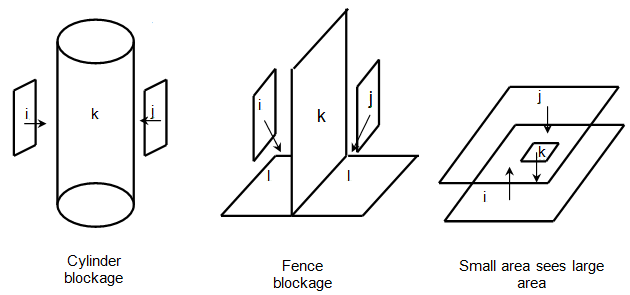Inaccuracies due to non-uniform illumination
Radiation calculations with view factors assume uniform illumination over an element, and potentially significant errors may be introduced when this assumption is not fulfilled.
The cylinder blockage problem, the fence blockage problem, and the small area seeing a large area problem are types of errors introduced by non-uniform illumination.

In the cylinder blockage problem, radiation from element i cannot reach j because of blockage by cylinder k. However, if cylinder k is modeled as a single element and thus has a single reflecting surface, because of the uniform illumination assumption inherent in the view factor definition it is assumed that some of the radiation will be reflected onto j, which is clearly incorrect. To avoid this problem, if a cylinder can cause significant blockage then model its surface with a series of planar elements.
In the fence blockage problem, i and j cannot see each other because they are blocked by fence k. However, the edges of fence k do not line up with element l, which can see both i and j. Since both i and j are assumed to illuminate l uniformly, l incorrectly reflects radiation from i to j. The solution here is to create a mesh so that the edge of l lines up with the edge of k, or, if this is not possible, use smaller elements along the projection of k.
When a small area sees a large area with a large view factor, element k is a small black area that is very close to reflective element i. Element i in turn has a large view factor to black element j. Then, very little of the radiation originating from k should be reflected away from i, most of it should bounce back to k and be re-absorbed. However, because the radiation incident upon i is assumed to be uniform, and radiation is reflected in proportion to the view factors, most of the radiation from k is incorrectly computed to be reflected onto and absorbed by j. The solution here is to subdivide element i into smaller sub-elements.
Highly reflective surfaces and coarse meshes generally aggravate problems due to non-uniform illumination.
